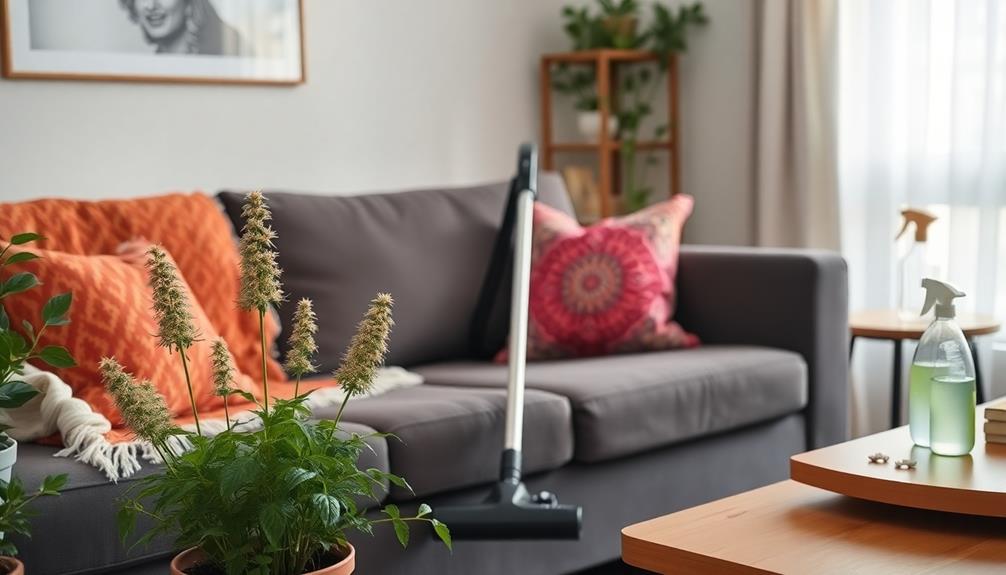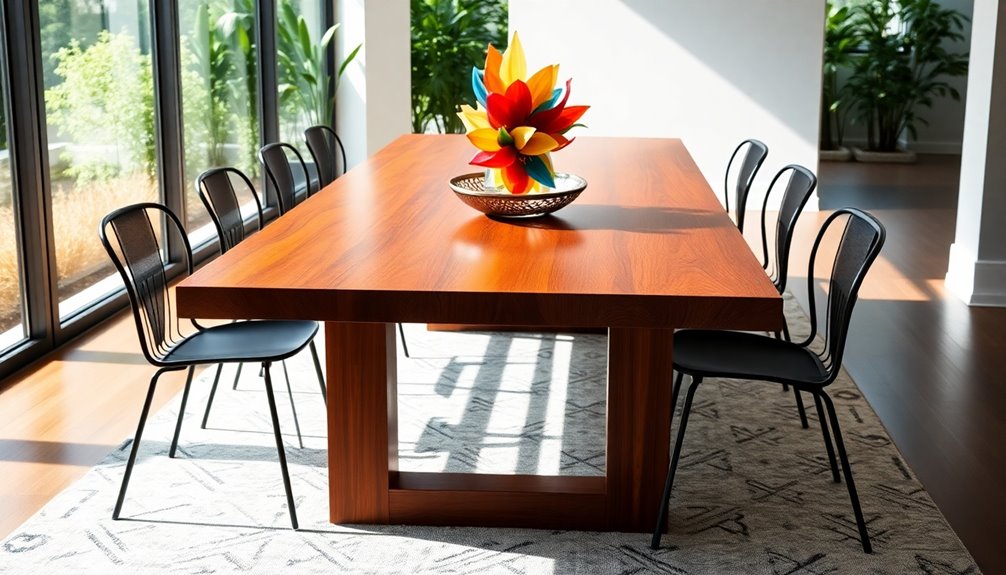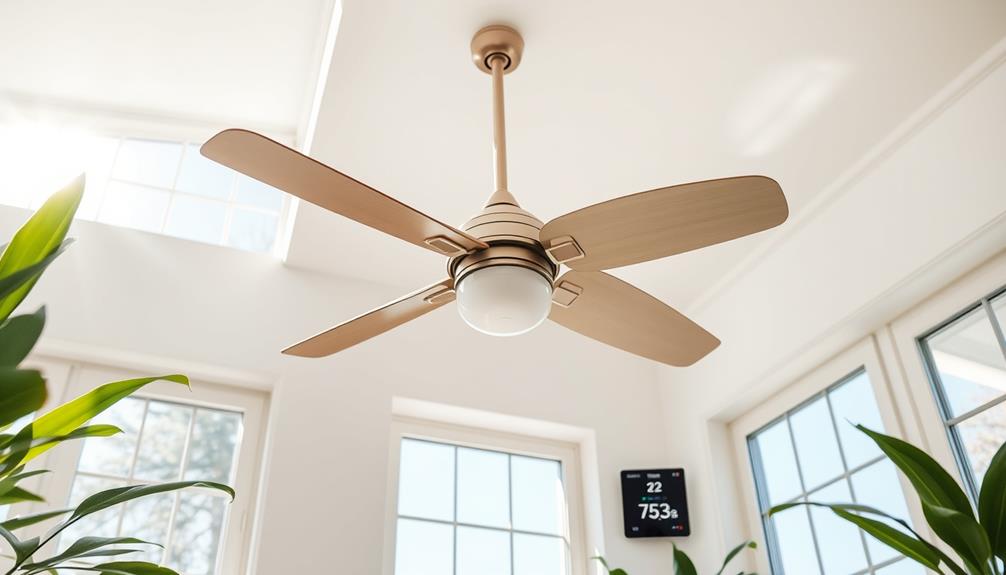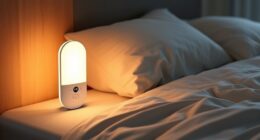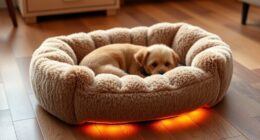To eliminate fleas from your furniture, begin by thoroughly vacuuming. Pay close attention to seams and crevices, and promptly dispose of the vacuum contents in a sealed bag. Then, utilize natural remedies such as baking soda or lemon citrus spray to dehydrate and repel fleas. For more serious infestations, consider using targeted chemical treatments while wearing gloves for safety. Remember to regularly wash pet bedding and wear protective gear when handling chemicals. Implementing a consistent vacuuming and cleaning schedule will help prevent fleas from returning. If you continue to experience persistent issues, there are additional steps you can take to ensure your home remains flea-free.
Key Takeaways
- Regularly vacuum furniture, focusing on seams and crevices to remove fleas, eggs, and larvae effectively.
- Apply baking soda or salt on carpets to dehydrate and kill adult fleas.
- Use natural remedies like lemon citrus spray to repel fleas safely in pet-friendly areas.
- Consider targeted chemical treatments for immediate relief, ensuring proper ventilation and safety measures during application.
- If infestations persist, contact a professional pest control service for comprehensive treatment and prevention strategies.
Understanding Flea Infestations
Understanding flea infestations starts with recognizing how quickly they can take over your home. A single female flea can lay up to 50 eggs each day, leading to rapid population growth.
Adult fleas often live on your pets but can easily jump onto your furniture and carpets, making infested areas tough to treat. Flea eggs, larvae, and pupae hide in various nooks and crannies, including furniture fabrics and cracks. To effectively get rid of fleas, you need to target all life stages. Regular cleaning and maintenance of your pet's environment is vital to preventing infestations, as well as ensuring a proper diet to keep their immune system strong, similar to maintaining a healthy hamster care routine with proper diet and care.
The flea lifecycle can last from a few weeks to several months, depending on environmental conditions. This variability complicates eradication efforts, so a thorough approach is essential.
Regular vacuuming helps control flea populations by disrupting their lifecycle and removing eggs and larvae. You might also consider using household items like baking soda or salt, which can absorb moisture and kill larvae.
In your pest control efforts, remember that persistence is key. By combining these strategies, you can greatly reduce flea populations in your home and protect your pets, ensuring a flea-free environment.
Essential Tools for Treatment
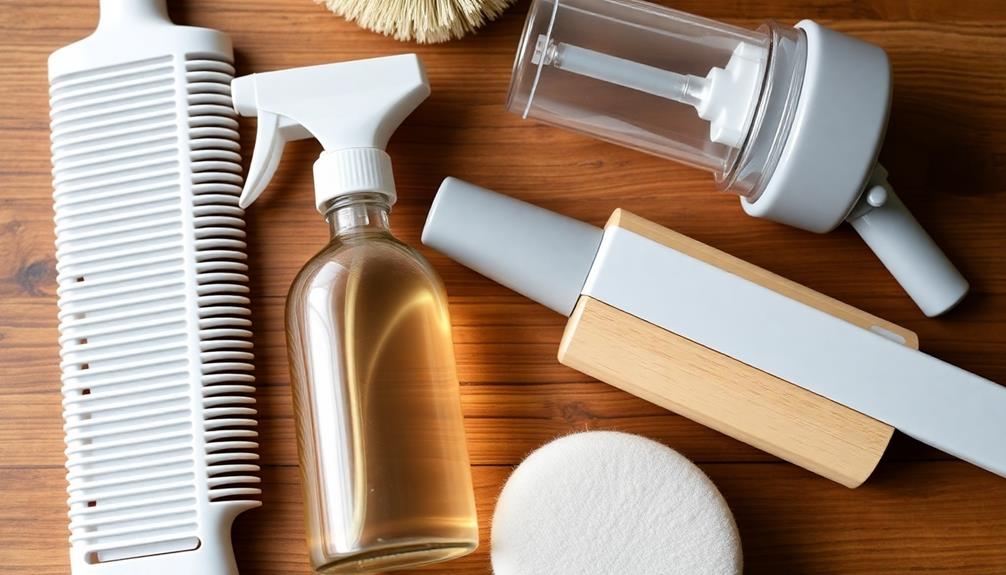
To effectively tackle a flea infestation on your furniture, you'll need the right tools at your disposal. Start with a high-powered vacuum cleaner; this is vital for removing adult fleas, larvae, and eggs from both furniture and carpets. Make sure to empty the vacuum immediately into an outside bin to prevent re-infestation.
Additionally, consider using natural remedies alongside conventional methods for thorough control, as suggested in cold medications overview.
Next, gather some baking soda and salt. These common household items act as natural dehydrate agents. Sprinkle them on your furniture and vacuum after a couple of days for effective flea control.
You'll also want targeted aerosol sprays designed for flea control. Use these for immediate action on your furniture, but remember to test them on inconspicuous areas first to avoid any staining.
A hard brush is another key tool. A stiff-bristled brush helps work baking soda or salt into fabric furniture, ensuring thorough coverage and enhancing the treatments' effectiveness.
Finally, don't forget protective gear; wearing rubber gloves during the application of any pest control products is essential. This helps safeguard against skin irritation and keeps your treatment process hygienic.
With these essential tools, you'll be well-equipped to tackle that flea problem.
Step-by-Step Vacuuming Technique
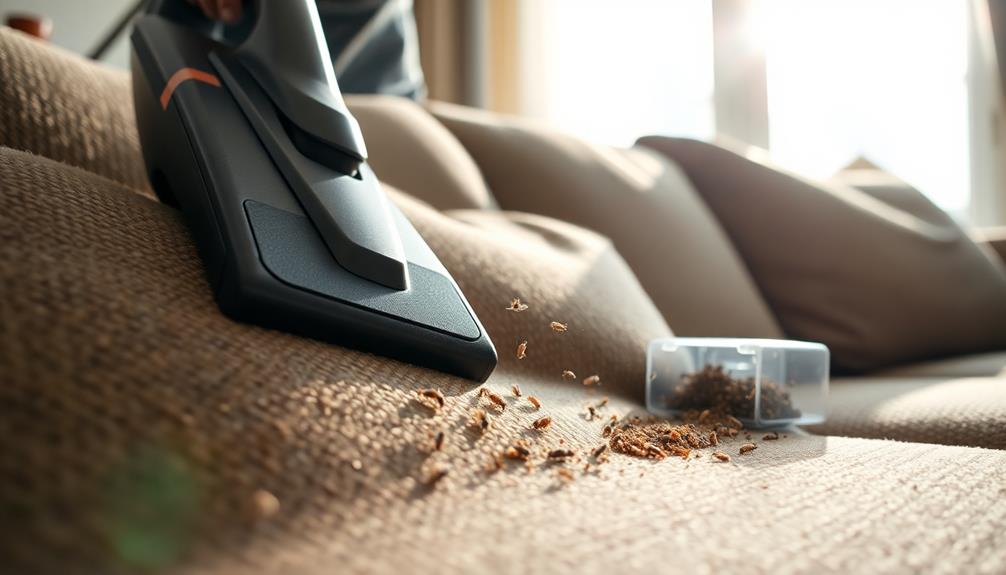
To tackle fleas on your furniture, you need the right vacuuming equipment and a solid technique. Regular vacuuming not only helps remove fleas but also dirt and allergens, contributing to a healthier living environment.
Start by focusing on seams and crevices, then properly dispose of the vacuum contents to keep fleas at bay.
For additional pest management tips, consider checking out effective natural ingredients for grout cleaning. Regular vacuuming is key, so make it a habit, especially in pet areas.
Proper Vacuuming Equipment
Effective vacuuming is essential for tackling flea infestations on furniture. To guarantee your vacuuming equipment is up to the task, consider the following:
- HEPA Filter: Use a vacuum cleaner equipped with a HEPA filter to effectively trap fleas, eggs, and larvae while minimizing allergens.
- Strong Suction Power: Choose a vacuum with strong suction power to lift fleas and debris from carpets and upholstery.
- Brush Attachment: Incorporate a brush attachment to agitate and lift fleas from hard-to-reach areas in your furniture.
- Sealed Bags: Confirm your vacuum uses sealed bags for easy disposal of contents, preventing any chance of re-infestation.
When vacuuming, don't forget to target all areas of your furniture, including under cushions and in seams, as fleas like to hide in these spots.
After you've finished, empty the vacuum contents into a sealed bag and dispose of it outside. Regularly vacuuming at least once a week during flea season will help maintain control and reduce the likelihood of re-infestation.
With the right equipment, you'll be well on your way to a flea-free home.
Vacuuming Technique Steps
A thorough vacuuming technique is vital for eliminating fleas from your furniture. Begin by using a vacuum cleaner with strong suction and a HEPA filter. This setup effectively captures fleas, their eggs, and larvae.
Start at the top of your furniture and work your way down, ensuring you cover every surface thoroughly. Pay special attention to seams, crevices, and under cushions, as these are prime hiding spots for fleas.
Use a vacuum attachment specifically designed for upholstery to maximize effectiveness on fabric surfaces. Move slowly, allowing the vacuum to pick up all debris and pests. If there are any stubborn stains or embedded dirt, consider using a fabric cleaner or upholstery shampoo before vacuuming. It’s also important to regularly maintain and clean your upholstery to prevent build-up and prolong its lifespan. Furthermore, if you need to deep clean your upholstery, consider moving a sofa with a dolly to access all sides and corners for a thorough cleaning. This can also make it easier to vacuum underneath and around the sofa for a complete clean.
Once you've vacuumed all affected areas, immediately dispose of the vacuum contents in an outside bin. This step is important to prevent any chance of re-infestation.
To break the flea life cycle and reduce their population, vacuum regularly—ideally every few days—for at least two weeks. Consistency is key in your battle against these pests.
Disposal of Contents
After you've thoroughly vacuumed your furniture to remove fleas and their eggs, it's time to focus on the disposal of the vacuum contents. Proper disposal is vital to prevent re-infestation in your home.
Here's how to do it effectively:
- Seal Vacuum Bags: If you're using a bagged vacuum, seal the bag tightly to guarantee no fleas escape.
- Empty Canister Outdoors: If you have a bagless vacuum, empty the canister directly into an outdoor trash bin. This minimizes the risk of fleas returning to your living space.
- Use a HEPA Filter: If possible, choose a vacuum with a HEPA filter. It'll trap even the tiniest flea eggs and larvae, enhancing your flea control efforts.
- Regular Maintenance: Make a habit of regularly vacuuming upholstered furniture, including crevices and under cushions. This consistently reduces the flea population.
Natural Remedies for Fleas
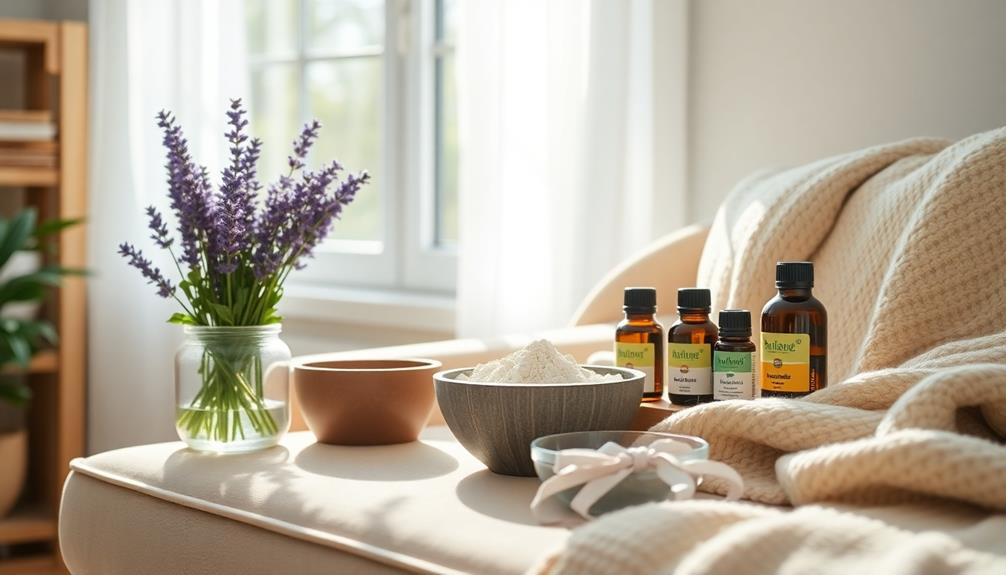
If you're looking for natural ways to tackle fleas, consider using baking soda and a citrus spray.
Sprinkling baking soda on your furniture can help dry out those pesky pests, while a lemon citrus spray acts as a strong deterrent.
Both methods are simple to apply and can make a noticeable difference in your flea problem.
Baking Soda Application
Many homeowners find baking soda to be an effective natural remedy for tackling fleas on furniture. This simple ingredient works by dehydrating adult fleas, making it a safe pest control option.
Here's how you can use it effectively:
- Sprinkle: Generously sprinkle baking soda on your furniture and carpets.
- Brush: Rub it into the fabric with a hard brush, ensuring it penetrates deep into the fibers.
- Let it Sit: Allow the baking soda to sit for several hours or overnight to maximize its dehydrating effect.
- Vacuum: Vacuum thoroughly to remove both dead fleas and any remaining baking soda residue.
After vacuuming, make sure to dispose of the contents in an outside bin. This step's essential to prevent any lingering fleas from making a comeback in your home.
Regular application of baking soda can help manage flea populations, but remember, continuous treatment is necessary due to the potential for re-infestation from eggs and larvae.
Lemon Citrus Spray
Lemon Citrus Spray is a powerful natural remedy for combating fleas on your furniture. To make it, slice a lemon and boil it in water, allowing the mixture to sit overnight for maximum potency. This simple preparation creates a potent spray that acts as a natural repellent for fleas, making it a safe alternative to chemical treatments, especially in homes with pets and children.
When applying the spray, focus on infested areas like sofas and pet bedding. Make certain the surfaces are dampened but not soaked to avoid damage. Regular application can help manage flea populations effectively, but keep in mind that it may not eliminate eggs and larvae entirely. Ongoing treatment is necessary for thorough control.
Before applying the spray to larger areas, always test it on a small, inconspicuous section of your furniture. This precaution helps prevent potential staining and guarantees your furniture remains in good condition.
With consistent use, Lemon Citrus Spray can be an essential part of your flea control strategy, keeping your home safe and comfortable for everyone.
Application of Chemical Treatments
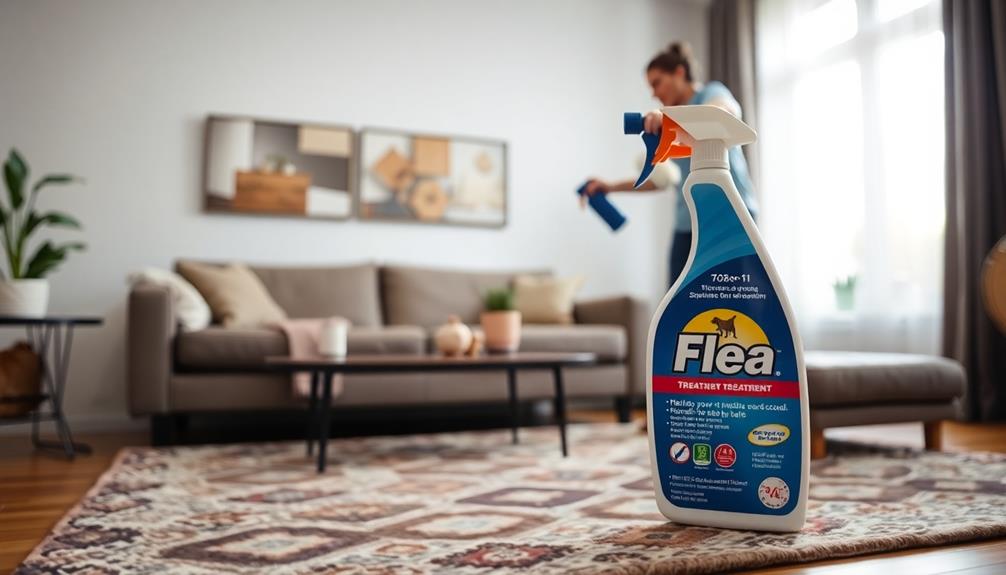
When tackling a flea infestation on your furniture, applying chemical treatments effectively is essential for success. Here's a quick guide to help you get started:
- Choose the Right Products: Opt for a boric acid and botanically based pesticide mixture that targets both adult fleas and their larvae.
- Use Proper Application Techniques: Employ a dust application method, working the mixture into the fabric of your furniture for maximum effect in infested areas.
- Wear Protective Gear: Always put on rubber gloves during the application to protect your skin from irritation and drying effects.
- Ensure Safety Measures: Test aerosol sprays on a small, inconspicuous area of the furniture to avoid staining. Make sure the room is well-ventilated and keep pets and children away until the treatments have dried and the area is safe.
Following these steps will help you effectively eliminate fleas from your furniture.
Dealing With Severe Infestations
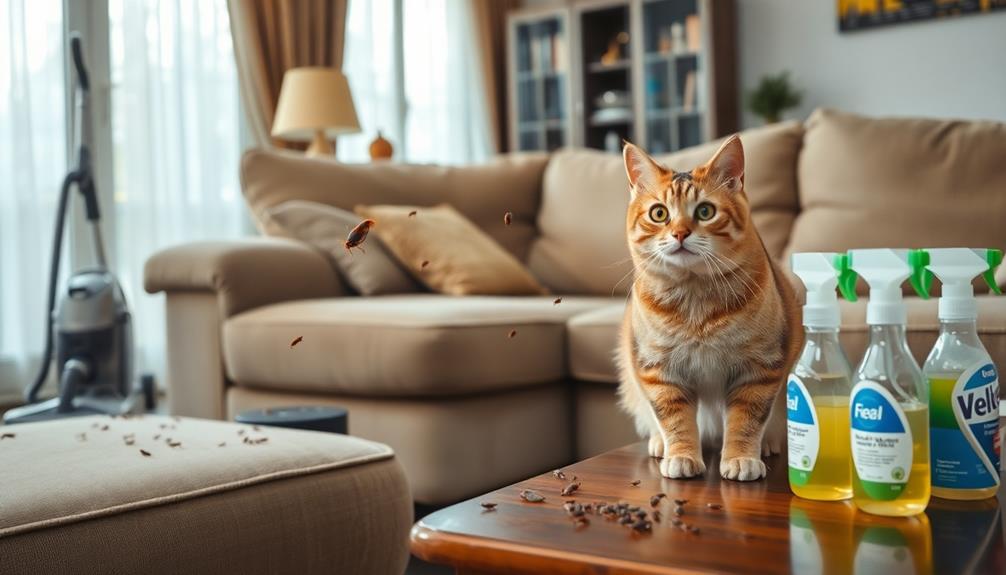
Severe flea infestations can feel overwhelming, but taking decisive action can help you regain control of your home. Start by using an aerosol spray designed for immediate relief. This method effectively targets adult fleas and can provide rapid results.
Avoid foggers or bombs, as they disperse chemicals uncontrollably and mightn't reach all infested areas.
When applying the aerosol spray, focus on spots where fleas are concentrated, like under cushions and in crevices. This targeted approach maximizes the impact of your treatment.
After applying the spray, monitor its effectiveness and be prepared to reapply as needed to fully tackle the infestation.
Regular vacuuming is essential after treatment. It helps remove dead fleas and prevents re-infestation. Make sure to dispose of vacuum bags immediately to eliminate any remaining eggs or larvae.
This proactive step will help break the flea life cycle and keep your home flea-free.
Stay vigilant and consistent with your efforts, as dealing with severe infestations may take time. With the right approach and persistence, you can successfully reclaim your space from these pesky intruders.
Maintaining a Flea-Free Environment
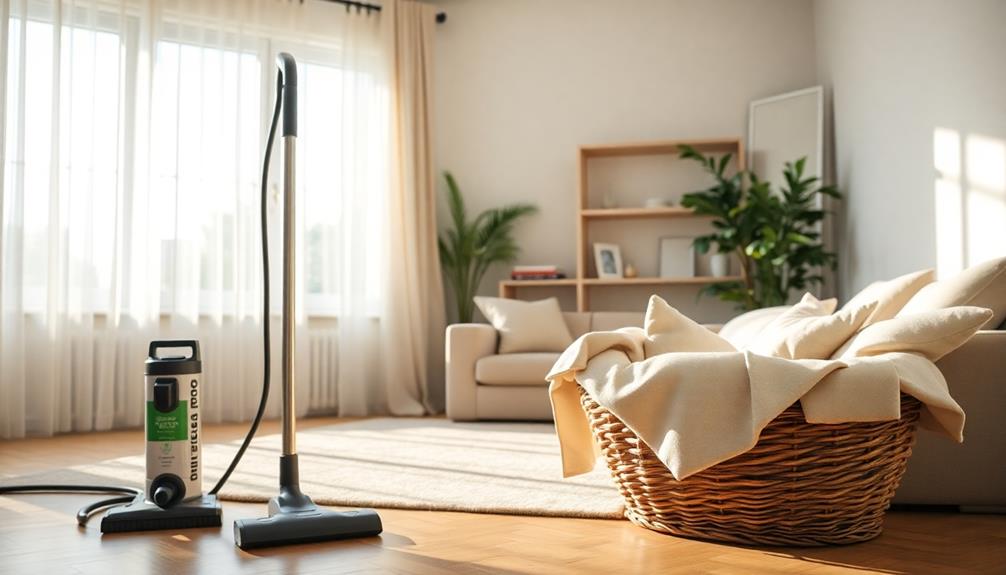
To keep your home free from fleas, you'll want to take a proactive approach with regular maintenance. Establishing a routine will help you stay one step ahead and prevent re-infestation.
Here are four essential steps to maintain a flea-free environment:
1. Vacuum Regularly: Vacuum your furniture and carpets at least once a week to remove adult fleas, larvae, and eggs.
Don't forget to dispose of the vacuum contents in an outside bin.
2. Use Baking Soda or Salt: Sprinkle baking soda or salt on carpets and furniture.
Let it sit for 1-2 days to dehydrate and kill adult fleas, then vacuum thoroughly.
3. Apply Citrus Spray: Create a natural flea deterrent by boiling lemons in water.
Use this citrus spray on infested areas like sofas and pet bedding to repel fleas.
4. Wash Pet Bedding: Regularly wash pet bedding and any removable fabric covers in hot water to eliminate fleas and their eggs.
Safety Measures During Treatment
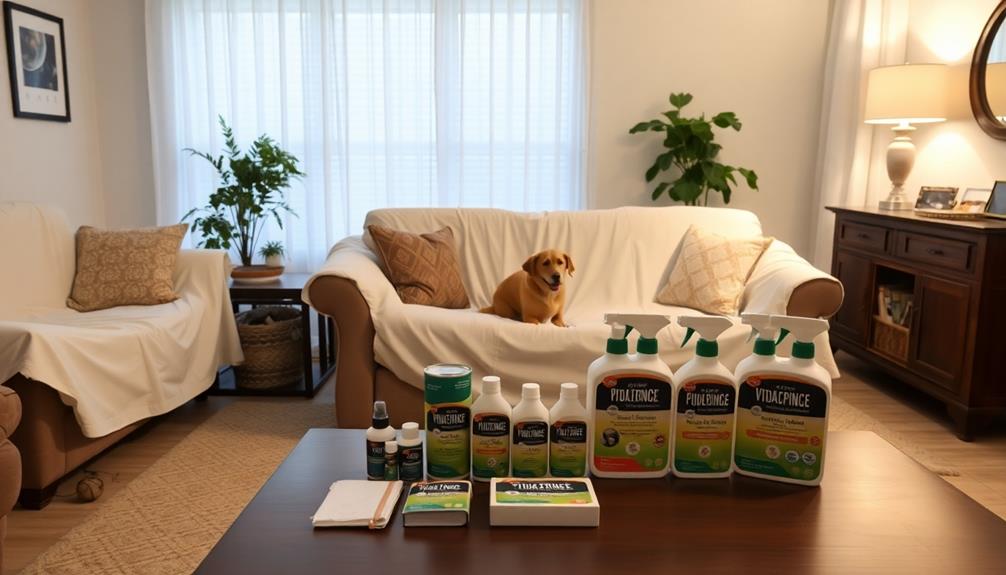
Ensuring safety during flea treatment is essential for you, your pets, and your family. Start by always wearing gloves when applying flea treatments. This protects your skin from irritation and the drying effects of harsh chemicals.
When using aerosol products, make sure the area is well-ventilated. This helps prevent inhaling harmful fumes that could affect your health.
It's crucial to keep pets and children away from treated areas until they're completely dry. This minimizes their exposure to potentially harmful chemicals.
Store all flea control chemicals in a secure location, away from living areas. Doing so prevents accidental ingestion or contact, keeping your loved ones safe.
When to Call Professionals
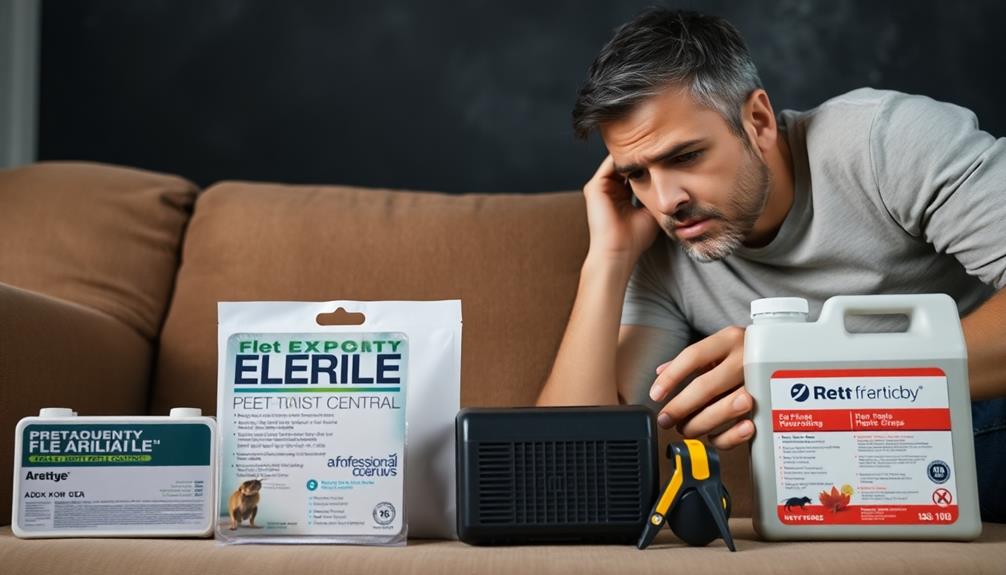
When fleas turn your living room into a battleground, it's time to contemplate calling in the professionals. Here are some signs that indicate you should reach out for expert help:
- Severe Infestation: If you notice a high number of adult fleas, a professional can effectively tackle both adult fleas and their immature stages.
- Ineffective Home Remedies: If your attempts at DIY solutions haven't yielded results after several applications, it might be time for a more robust approach.
- Comprehensive Treatment Needs: Professionals employ treatments that not only target visible fleas but also the eggs and larvae hiding in your furniture and carpets.
- Preventative Measures: Experts can offer advice on how to avoid re-infestation, which can be challenging for homeowners to manage independently.
Local pest control companies, like Rentokil, specialize in thorough coverage and monitoring of flea populations.
Don't let fleas take over your home—getting professional help can save you time and hassle, ensuring a flea-free living space in no time.
Frequently Asked Questions
How to Get Rid of Fleas From a Sofa?
To get rid of fleas from your sofa, sprinkle baking soda or salt, rub it in, and vacuum thoroughly. You can also use a citrus spray to target adult fleas without soaking the fabric. Be sure to empty the vacuum canister or dispose of the vacuum bag outside immediately to prevent the fleas from returning. For a more thorough cleaning, you may consider steam cleaning the fabric, which can help eliminate flea eggs as well. While tackling pests, remember that common household remedies, like when removing paint from wood furniture, often require patience and care to avoid damaging surfaces or fabrics. Additionally, it’s a good idea to wash any pet bedding and use flea treatments on your pets to prevent further infestations. If you’re dealing with stubborn smells, such as trying to remove dog gland odor from furniture, specialized cleaning products designed for pet odors may help neutralize the smell without damaging the fabric. Always test any product in a small, inconspicuous area to ensure it won’t cause discoloration or harm to your sofa’s surface.
How Long Will Fleas Live on a Couch?
"Where there's smoke, there's fire." Fleas can live on a couch for several days to weeks, and under ideal conditions, they might survive up to 100 days, so tackling them promptly's essential to prevent infestations.
Can You Spray Something on Furniture to Kill Fleas?
Yes, you can spray specific insecticides on furniture to kill fleas. Just make certain the product's safe for fabrics. Alternatively, homemade citrus sprays work well too. Always test on a small area first for safety.
What Can I Spray on a Mattress to Kill Fleas?
You can spray a citrus solution or a vinegar-water mix on your mattress to kill fleas. For stronger results, consider using a commercial flea spray, but always follow the instructions and guarantee proper ventilation.
Conclusion
In your quest to banish those pesky fleas from your furniture, remember: victory is within reach! With a little grit and a few effective methods, you can reclaim your space from these tiny tyrants. Imagine lounging on your couch, free from those relentless, biting invaders—pure bliss! So grab your vacuum, whip up some natural remedies, or call in the pros if needed. Your flea-free sanctuary awaits, and it's going to feel like a five-star hotel!
